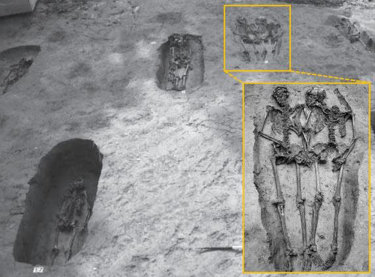
"We were able to ... confidently classify them as males," scientists from the University of Bologna said in the journal Scientific Reports.

The burial site near the Italian town of Modena, where the famous "Lovers of Modena" skeletons are buried. Credit:PA
The exact relationship between the two men remains a mystery. Researchers are convinced that they were intentionally buried hand-in-hand and suggest they may have been brothers, or soldiers who died together in battle.
The latter theory is supported by the fact that other skeletons found in the cemetery showed signs of trauma, "likely related to their violent death during war conflicts", the team said.
"The two 'lovers' could have been war comrades or friends, who died together during a skirmish and were buried within the same grave.
"Alternatively, the two individuals were relatives, possibly cousins or brothers given their similar ages, sharing the same grave due to their family bond."
Federico Lugli, the lead author of the findings, told Italy's Rai television network: "Many tombs have been found in the past with couples holding hands, but in those cases it was a man and a woman. What may have been the bond between these two individuals is a mystery."
The research team said: "The discovery of two adult males intentionally buried hand-in-hand may have profound implications for our understanding of funerary practices in Late Antique Italy."
It was unlikely the men were gay, the scientists said. Social attitudes and Christian beliefs meant that the "deliberate manifestation of a homosexual relationship" would have been severely frowned on during the era in which the men died. During the rule of the Emperor Justinian, from AD527 to AD565, "sex between males was fully considered a crime".
The team said the finding was unique - there have been many cases of men and women buried hand-in-hand in the past, but none of two men.









 Add Category
Add Category